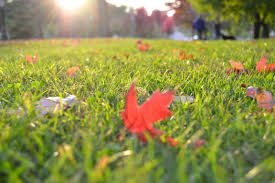While your lawn might not be foremost on your mind with winter coming, snow and cold can do serious damage. By making preparations now, you can reduce the effects of moisture, cold and snow mold to help your grass come back full and lush next spring.
Control Your Leaves
Left undisturbed, fall leaves can create a thick mat of rotting material that blocks air and sunlight from the grass, keeping it from absorbing the nutrients it needs to survive the winter. Once it starts snowing, this layer holds in moisture that encourages the growth of snow mold.
Honda’s mulching mowers are designed to handle large amounts of lawn debris, even if it’s wet. If you mow frequently as the leaves fall, you’ll be able to turn those leaves into mulch, feeding the soil and reducing the money you need to spend on yard waste disposal. Expect to mow at least twice a week at the peak of the season. If the number of leaves gets out of hand, you should collect and dispose of them either by creating a mulch pile or by having them collected as yard waste.
Fertilize, but Not Too Much
By now, the time for fall fertilizing has passed in most of the country, but if you’re still a few weeks away from winter, now is a good time to get a soil sample tested so you can use the right mix on your soil. Nitrogen is emphasized in fall fertilizer mixes to encourage chlorophyll production and the resulting sugar stores needed to survive the winter, but too much can promote the growth of snow mold. This makes it critical to get the right balance to supplement your grass without opening it up to infection.
Cut Your Grass Short
The less grass you have, the less moisture it can hold. Ideally, the blades should be around an inch in height, but you may need to go a little higher to keep from cutting into crowns. Remember never to mow more than 1/3 of the grass blades at one time. Warm season grasses should stop growing after the first freeze, while cool-season grasses may grow just enough to need one more mow after the initial freeze.
Be Careful with Hibernating Grass
Both warm and cool season grasses should stop growing once temperatures are regularly below 40°F (4-5°C) and enter hibernation. Photosynthesis shuts down, the blades of grass turn brown and the plant starts using the sugar stores collected through the later summer and fall. In this state, the grass is very sensitive to damage, especially if it’s covered in frost. At this point, the grass shouldn’t be mowed; walking and any other contact with the ground should be kept to a minimum.
Spread Out Snow
When most of us use our snowblowers, we simply aim the chute to get the snow away from the area we’re clearing. This centers the snow on one area, creating a pile that is thermally insulated, slowing down the melting process. In turn, it keeps the ground underneath wetter longer, encouraging the growth of snow mold and the washing away of mud surrounding the grass. To keep this from happening, try to adjust the chute angle to drop the snow in a different spot with each pass, spreading it out over a wider area.
Take Care of Your Equipment, and Your Equipment Will Take Care of Your Lawn
If you have Honda power equipment or a Honda small engine, you can get everything you need for it at www.hondalawnparts.com. We’re a certified dealer for both arms of Honda’s outdoor equipment division, letting us ship OEM parts across the U.S. and Canada.


